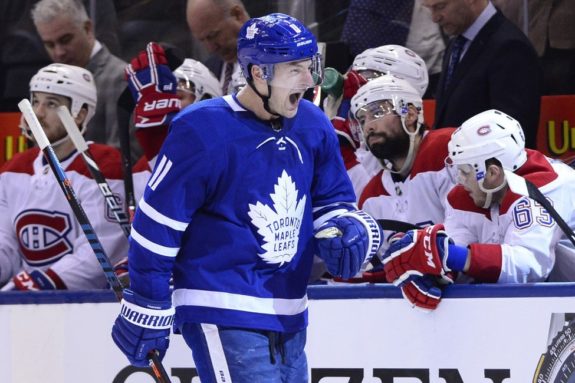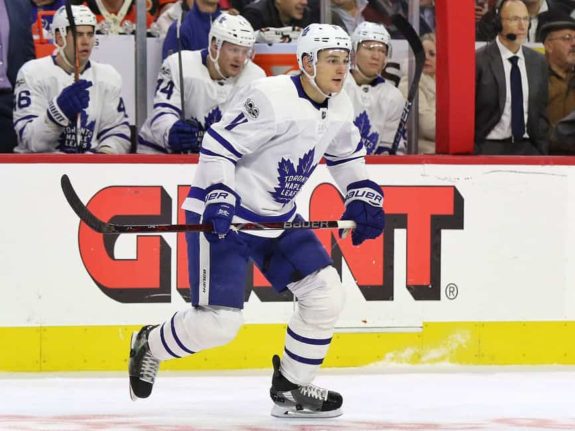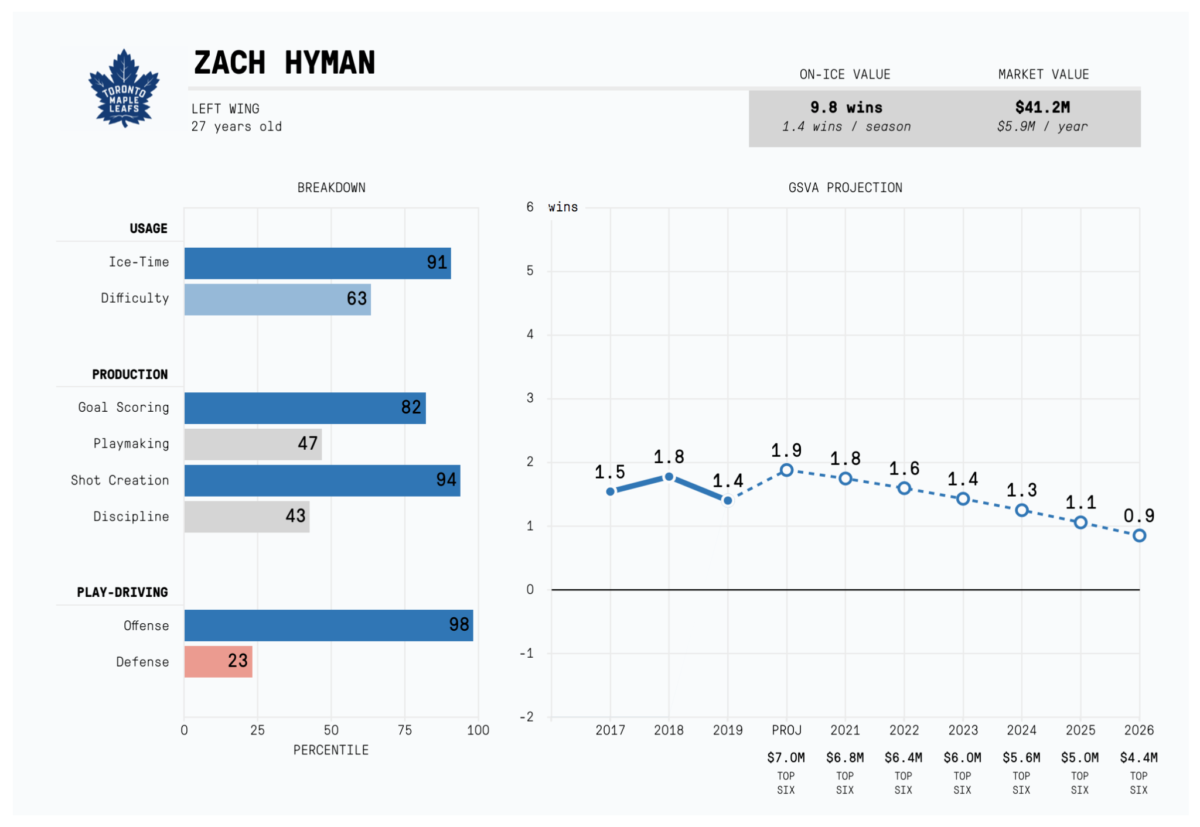For a team that has often been labeled as being in “salary cap hell,” the Toronto Maple Leafs have done a surprisingly good job of managing their money, especially as we project into the future. Their core four of Auston Matthews, John Tavares, Mitch Marner, and William Nylander are all locked up for at least four more seasons, and the blue line is looking stronger than ever with Morgan Rielly, Jake Muzzin, and TJ Brodie all signed for another two-to-four years as well.

Even with all of their costly core pieces signed, the Leafs project to have something in the range of $14 million in cap space next offseason, though there will be plenty of shuffling before then with the expansion draft and all.
Related: Maple Leafs News & Rumors: Warsofsky, Kerfoot, Hyman & More
The key for general manager Kyle Dubas has been eliminating the middle class, so to speak, which he accomplished by trading away Andreas Johnsson ($3.4 million) and Kasperi Kapanen ($3.2 million), then replacing them with cheaper options like Jimmy Vesey ($900,000) and Wayne Simmonds ($1.5 million). The only remaining member of that middle class is Alexander Kerfoot ($3.5 million) who, as the Maple Leafs’ best option at 3C, is arguably too indispensable to get rid of.
That brings us to 28-year-old Zach Hyman. With one year remaining on his contract, the gritty winger may very well be the next Leaf to join Kerfoot in that middle class. And going into what will likely be his last shot at a big payday in the NHL, Hyman will want to maximize his earnings on his next deal.

How much should the Leafs be willing to spend on the Toronto native? And what would a Hyman extension mean for the team’s roster construction and the salary cap in 2021-22 and beyond?
Hyman’s Impact Is Irreplaceable
It’s no secret that the Leafs are a high-powered offensive juggernaut with plenty of speed, skill, and finesse. But as we’ve seen in recent years, that skill must be complemented by some level of grit and tenacity, which the team has often lacked – especially in the playoffs. Judging by the moves they’ve made this offseason, the front office obviously believes the same, and if they want to maintain that facet as part of the team’s identity moving forward then Hyman will certainly be a big part of it.
Related: Maple Leafs Are More Competitive After Free Agent Signings
According to InStat, Hyman ranked second on the Maple Leafs in puck battles per game (18.2) during their qualifying series against the Columbus Blue Jackets, second only to Matthews (19.4). Unsurprisingly, he also ranked fifth among Leafs forwards in time spent on attack per game (9:47) behind the big four.

We know that Hyman is a fantastic forechecker that brings physicality and tenacity in spades; he’s the glue on any line, and his work down low in the offensive zone opens up space and scoring chances for both himself and his teammates. Over the last three seasons, he’s added an extra offensive dimension to his game that’s made him even more valuable.

Back in 2016-17, the feisty winger played his first full NHL season primarily on Matthews’ wing and primarily served as a hard forechecker and puck retriever. Hyman’s effectiveness was limited, though, by his lack of skill and scoring touch. Those criticisms, however, have been squashed over the last three seasons, with Hyman developing into a borderline first-line forward largely due to his improved goal scoring.
Related: Maple Leafs Would Dominate a Canadian Division in 2020-21
Since 2017-18, Hyman ranks 109th with 1.87 points per hour among NHL forwards, just behind big names (and former Maple Leafs) Nazem Kadri and Phil Kessel. This past season, he was the Leafs’ third most efficient 5v5 goal scorer after Matthews and Nylander. Of course, the Toronto native has had the benefit of spending most of his time flanking either Matthews or Tavares, but his ability to improve his game over time is extremely impressive, and further speaks to his competitiveness and will to win.
When you combine his consistent on-ice performance with those intangibles, it’s clear that the Maple Leafs cannot afford to let Hyman walk as a free agent next offseason.
How Much Is Hyman Worth?
Currently making $2.25 million, it goes without saying that Hyman has vastly outperformed his contract. He signed his four-year deal back in July 2017 after scoring just 10 goals and 28 points in 82 games, which looked like a fair price for a bottom-six grinder.
Hyman, who just scored 21 goals and 37 points in 51 games (a 34-goal, 59-point pace!), has arguably developed into an even better player than the Leafs could’ve imagined. He’s provided excellent value over these last three seasons, but the clock is ticking on his pending payday, and the Leafs will surely have to open up their wallets to keep him around. But just how much will he cost?

Let’s start with Hyman’s actual market value. Per Dom Luszczyszyn of The Athletic, Hyman’s true value going into next season is a whopping $7 million, and he should remain at least a $5 million player until 2025-26. Now do not mistake this for a contract projection: Luszczyszyn is not saying that the 6-foot-1 winger will be paid $6-7 million on his next deal, but that’s how much on-ice value he brings to the team according to his model (which takes into account much more than just box score stats, unlike NHL contracts).
Related: Maple Leafs News & Rumors: Goalie Considerations and an NHL Restart
With this knowledge, the Leafs can be confident in giving Hyman a sizeable raise over his current contract. He’s established himself as a consistent play driver and producer, and certainly provides more value than his 40-point track record might suggest.

The only real worry about Hyman is his age and longevity, especially given his heavy style of play. At 28, he is already nearing the end of his prime in terms of production so I wouldn’t be surprised to see his scoring slowly taper off in the next couple of seasons. However, as a late bloomer and extraordinarily hard worker, there is a good chance that he can maintain his prime for longer than average, but the aging curve is still certainly something to be wary of.
On the latest episode of The Leaf Report, James Mirtle, Jonas Siegel, and Chris Johnston touched on Hyman’s pending extension, arguing that Tampa Bay Lightning forward Alexander Killorn is a good comparable. Killorn signed a seven-year deal back in 2016 with an average annual value (AAV) of $4.45 million per season, taking him from his age 27 season to age 33. The left winger has been a consistent 15-20 goal, 40-50 point man for Tampa while playing a relatively heavy game, putting him in the same ballpark as Hyman.

Aside from the statistical similarities, the logic for comparing Hyman to Killorn is in the length of the contract. The Leaf Report trio argued that if the Leafs want to keep Hyman’s AAV down, they’ll have to give him a long-term deal in the neighborhood of six-to-eight years.
Related: Brodie Signing Makes Maple Leafs Defence a Strength
Hyman will be 29 by the time his next contract kicks in, so the idea of a long-term deal is at best somewhat worrying and at worst a potential disaster. If we follow Luszczyszyn’s projection, Hyman will still be a top-six player six years from now, though his Game Score Value Added (GSVA) will be cut in half compared to his current value.
Unfortunately in the world of long-term NHL contracts, you’re usually paying for current production and worry about the repercussions of a player’s decline later. But if the Leafs want to keep Hyman around, that may very well be the cost of doing business.
Can the Maple Leafs Afford Hyman?
If we simply give Hyman the Killorn contract and correct for the inflated salary cap, which has increased by $8 million since 2016-17, then the Leafs winger should earn $5 million on a six-to-eight year deal. That may sound like a big number but it’s still nearly $1 million less than Luszczyszyn’s projection for Hyman’s long-term value.
If we’re a bit more optimistic and assume that the hometown boy will take a bit of a discount to stay in Toronto, then perhaps that number can be pulled down towards $4 or $4.5 million. And according to the Leafs’ roster projection for 2021-22, that will likely need to happen to keep Hyman around.

It’s hard to predict what the Leafs’ roster will look like a year from now, but I did my best without making any crazy moves. To keep things simple, I re-signed goaltender Frederik Andersen at the same $5 million cap hit, gave Travis Dermott a slight raise, and brought back Jason Spezza for the league minimum. I also brought in some fresh faces like Nick Robertson, Yegor Korshkov, Rasmus Sandin, and Timothy Liljegren to round out the bottom of the roster, while Justin Holl was taken by the Seattle Kraken in the expansion draft.
Related: Maple Leafs’ Nick Robertson Must Play Regularly This Season
Because of the flat cap the Maple Leafs are still pretty tight on money, with just about $4.6 million in space and Hyman still unsigned. If we stick strictly to the Killorn contract, Hyman will command $5 million, meaning the Leafs would have to move someone out to make space. If we’re a bit more optimistic and believe he’ll take a slight discount, then the team can probably squeeze him in and fit just under the cap with a 20-man roster.
Given Hyman’s undeniable value to the team and his insistence on winning in Toronto, I’m confident that a deal will get done between the two sides when the time is right. It may just take some maneuvering to get there.
Stats from InStat Hockey and naturalstattrick.com